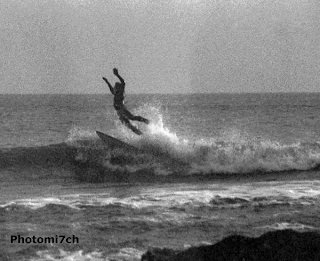An
acquaintance recently posted that he was having trouble with his
photographs. The prints were
producing brown stains on the edges and face of the paper which he
had not seen before. He went on to describe a process that does not
include stop bath. I have always accepted that stop was essential
when printing.
This
revelation made me stop and think about all of the books I have read
over the years on photograph production. As far as I was aware none
of them said that there was a choice. Just to be sure I went back to
the reference books on the subject I trust most. After consulting Tim Rudman Master Printing course, Michael Langford Basic Photography
and Ansel Adams The Print - by the way this is the only book to
explain what happens when stop is omitted.
Ansel
Adams writes: That stop bath is a weak solution of acetic acid that
neutralizes the alkalinity in the developer stopping development
straight away. Fix being acidic would have the same affect as stop
bath but it prevents the contamination of the fix from the alkaline
in developer which quickly exhausts the fix making it more likely
that the prints will stain.
I
should point out that my acquaintance has been producing prints
that have not shown any signs of staining till now. It turns out that
it was a lack of proper washing before the fix that was causing the
problem and not exhausted fix.
The
question that keeps coming into my head is why wouldn't you use stop?
It makes no sense from my point of view. I spend a lot of time in the
darkroom making test prints carefully choosing the right amount of
light for exposure. Once in the developer I watch and wait for what I
judge to be the right amount of development so I can remove it to the
stop, freezing it at that point in the process. If this was
substituted for water this would not be the case it would only slow
down development making a mockery of all the careful planning gone
before and adding a degree of uncertainty as to whether or not it was
going to stain.
This
is one of the main issues I have with not using stop bath which for
me translates to film as well. You spend all that time getting the
time, temperature and inversion right, - for what? Because you can
not be bothered to use stop?it's to expensive? I will admit to not
using stop at one point but not for the reasons given earlier when
developing film. I reverted back to stop mainly because I did not
like the look of the negatives it was producing. They seemed to have
a soft look to them.
I know that this must sound like a bit of a rant and to a certain extent it is. Sometimes it's good to get things off your chest. As far as I'm concerned there are many different paths to creative nirvana and how you reach it is up to you.
Since writing this I have discovered a number of print developers that do not require a stop bath. As long as you use running water in its place for at least thirty seconds. These developers use Amidol in the formula. They can be found in The darkroom cookbook.





























